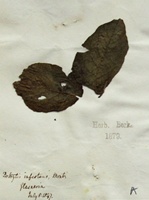Scientists identify pest that caused 19th century Irish potato famine
22 May 2013
Scientists have identified the pathogen responsible for the Irish potato famine, using plant samples collected in the mid-19 th century.
A plant pest that caused potato blight struck Ireland in 1845 triggering a famine that claimed a million lives from starvation.
 |
| A potato specimen from the Kew Garden herbarium, collected in 1847, during the height of the Irish famine. The legend reads ''Botrytis infestans'', because it was not known yet that Phytophthora does not belong to the mildew causing Botrytis fungi. © Marco Thines/Senckenberg Gesellschaft für Naturforschung |
Scientists extracted DNA from museum specimens which revealed that the strain that changed history was different from modern day epidemics, and was now probably extinct - though potato and tomato crops continue to come under attack from other strains across the world.
Hundreds of millions of people suffer every year from damage to potato crop from the fungus-like infection.
A team led by The Sainsbury Laboratory, Norwich, traced the spread of potato blight across the world from the early 1800s to the present day.
Until now it had not been clear how early strains of Phytophthora infestans that caused around a million deaths in Ireland, were related to those present in the world today. Between 1846 and 1851, a million people in Ireland are estimated to have died of starvation and epidemic disease.
The number that emigrated over a period of a little more than a decade from 1845 is estimated at around 2 million.
Though the famine started as a natural disaster, according to historians, its effects were worsened by the actions and inactions of the Whig government of the time.
Two competing teams worked with 150-year-old dried leaves, to sequence the genome of the single-celled organism that was responsible for the devastation of Irish potato crop, the first ancient plant pathogen to have its genome decoded.
Phytophthora infestans, a type of single-celled organism related to brown algae is carried by infected potatoes. The disease spread from the port of Antwerp in Belgium where it probably arrived in the summer of 1845. It soon engulfed the Low Countries and much of western Europe.
The reason for the much greater toll in Ireland than in the rest of the continent was Ireland's critical dependence on potatoes. Irish peasants workingthe plots owned by absentee British landlords relied heavily on potatoes according to Detlef Weigel, a plant geneticist at the Max Planck Institute for Developmental Biology in Tübingen, Germany, who co-led a study published yesterday in the journal eLIFE1.
According to Weigel, the potato was an amazing staple crop and if people had a diet of potato and milk, they needed little of anything else.
The disappearance of that staple wreaked havoc leading to 1 million deaths and still more emigrations.
The perception that Britain did precious little to intervene in the catastrophe helped foment Irish nationalism, eventually resulting in the Irish War of Independence in 1919.(See: Whodunnit'' of Irish potato famine solved)






















